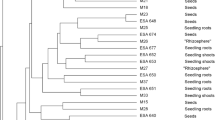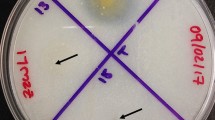Abstract
Maize is one of the most important crops worldwide, and in Brazil, the state of Paraná stands as its largest producer. The crop demands high inputs of N fertilizers, therefore all strategies aiming to optimize the grain production with lower inputs are very relevant. Endophytic bacteria have a high potential to increment maize grain yield by means of input via biological nitrogen fixation and/or plant growth promotion, in this last case increasing the absorption of water and nutrients by the plants. In this study, we established a collection of 217 endophytic bacteria, isolated from roots of four lineages and three hybrid genotypes of maize, and isolated in four different N-free culture media. Biochemical―comprising growth in different carbon sources, intrinsic tolerance to antibiotics, and biochemical tests for catalase, nitrate reductase, urease, and growth in N-free media in vitro―and genetic characterization by BOX-PCR revealed great variability among the isolates. Both commercial hybrids and homozygous lineages were broadly colonized by endophytes, and sequencing of the 16S rRNA gene revealed the presence of bacteria belonging to the genera Pantoea, Bacillus, Burkholderia, and Klebsiella. Qualitative differences in endophytic colonization were detected between lineages and hybrid genotypes.



Similar content being viewed by others
References
Altschul SF, Madden TL, Schaffer AA, Zhahg J, Zhang Z, Miller W, Lipman DJ (1997) Gapped BLAST and PSI-BLAST: a new generation of protein database search programs. Nucl Acids Res 25:3389–3402
Araújo WL, Lima AOS, Azevedo JL, Marcon J, Sobral JK, Lacava PT (2002) Manual: isolamento de microrganismos endofíticos. ESALQ, Piracicaba, São Paulo
Assumpção LC, Lacava PT, Dias ACF, Azevedo JL, Menten JOM (2009) Diversidade e potencial biotecnológico da comunidade bacteriana endofítica de semente de soja. Pesq Agropec Bras 44:503–510
Barretti PB, Souza RM, Pozza EA (2008) Bactérias endofíticas como agentes promotores do crescimento de plantas de tomateiro e de inibição in vitro de Ralstonia solanacearum. Ciênc Agrotec 32:731–739
Bashan Y, Holguin G, De-Bashan LE (2004) Azospirillum-plant relations physiological, molecular, agricultural, and environmental advances (1997–2003). Can J Microbiol 50:521–577
Bouton JH, Albrecht SL, Zuberer DA (1985) Screening and selection of pearl millet for root associated bacterial nitrogen fixation. Field Crops Res 11:131–139
Caballero-Mellado J, Carcano-Montiel M, Mascarua-Esparza MA (1992) Field inoculation of wheat (Triticum aestivum) with Azospirillum brasilense under temperate climate. Symbiosis 13:243–253
Coelho ASG (2000) BOOD v3.03: Avaliação de dendrogramas baseados em estimativas de distâncias/similaridades genéticas através do procedimento de bootstrap. UFG, Goiânia, Goiás, Brazil
Cruz LM, Souza EM, Weber OB, Baldani JI, Döbereiner J, Pedrosa FO (2001) 16S Ribosomal DNA characterization of nitrogen-fixing bacteria isolated from banana (Musa spp.) and pineapple (Ananas comosus (L.) Merril). Appl Environ Microbiol 67:2375–2379
Dobbelaere S, Vanderleyden J, Okon Y (2003) Plant growth-promoting effects of diazotrophs in the rhizosphere. Crit Rev Plant Sci 22:107–149
Döbereiner J, Andrade VO, Baldani VLD (1999) Protocolos para preparo de meios de cultura da Embrapa Agrobiologia. Embrapa CNPAB, Seropédica, Rio de Janeiro, Brazil
Garcia de Salamone IE, Döbereiner J, Urquiaga S, Boddey RM (1996) Biological nitrogen fixation in Azospirillum strain-maize genotype associations as evaluated by 15 N isotope dilution technique. Biol Fertil Soils 23:249–256
Glick BR (1995) The enhancement of plant growth by free-living bacteria. Can J Microbiol 41:109–117
Hall TA (2005) BioEdit: a user-friendly biological sequence alignment editor and analysis program for Windows 95/98/NT. http://www.mbio.ncsu.edu/BioEdit/bioedit.html
Hameeda B, Harini G, Rupela OP, Wani SP, Reddy G (2006) Growth promotion of maize by phosphate-solubilizing bacteria isolated from composts and macrofauna. Microbiol Res 163:234–242
Hungria M, Campo RJ, Souza EM, Pedrosa FO (2010) Inoculation with selected strains of Azospirillum brasilense and A. lipoferum improves yields of maize and wheat in Brazil. Plant Soil 331:413–425
Kapulnik Y, Okon Y, Henis Y (1987) Yield response of spring wheat cultivars (Triticum aestivum and T. turgidum) to inoculation with Azospirillum brasilense under field conditions. Biol Fertil Soils 4:27–35
Kaschuk G, Hungria M, Andrade DS, Campo RJ (2006) Genetic diversity of rhizobia associated with common bean grown under the no-tillage and conventional systems in South Brazil. Appl Soil Ecol 32:210–220
Kennedy IR, Choudhury ATMA, Kecskés ML (2004) Non-symbiotic bacterial diazotrophs in crop-farming systems: can their potential for plant growth promotion be better exploited? Soil Biol Biochem 36:1229–1244
Lacava PT, Andreote FD, Araújo WL, Azevedo JL (2006) Caracterização da comunidade bacteriana endofítica de citros por isolamento, PCR específico e DGGE. Pesq Agropec Bras 41:637–642
Machado HB, Funayama S, Rigo LU, Pedrosa FO (1991) Excretion of ammonium by Azospirillum brasiliense mutants resistant to ethlenediamine. Can J Microbiol 37:549–553
Marques ASA, Marchaison A, Gardan L, Samson R (2008) BOX-PCR-based identification of bacterial species belonging to Pseudomonas syringae–P. viridiflava group Gen. Mol Biol 31:106–115
Mendonça MM, Urquiaga SS, Reis VM (2006) Variabilidade genotípica de milho para acumulação de nitrogênio e contribuição da fixação biológica de nitrogênio. Pesq Agropec Bras 41:1681–1685
Menna P, Barcellos FG, Hungria M (2009) Phylogeny and taxonomy of a diverse collection of Bradyrhizobium strains based on multilocus sequence analysis of 16S rRNA, ITS, glnII, recA, atpD and dnaK genes. Int J Syst Evol Microbiol 59:2934–2950
Menna P, Hungria M, Barcellos FG, Bangel EV, Hess PN, Martínez-Romero E (2006) Molecular phylogeny based on the 16S rRNA gene of elite rhizobial strains used in Brazilian commercial inoculants. Syst Appl Microbiol 29:315–332
Okon Y, Labandera-Gonzalez CA (1994) Agronomic applications of Azospirillum: an evaluation of 20 years worldwide field inoculation. Soil Biol Biochem 26:1591–1601
Pedrosa FO, Yates MG (1984) Regulation of nitrogen fixation (nif) genes of Azospirillum brasiliense by nifA and ntrC (ginG) type genes. FEMS Microbiol Lett 55:95–101
Pelczar MJ, Chan ECS, Krieg NR (1996) Microbiologia: conceitos e aplicações. Makron Books, São Paulo, São Paulo, Brazil
Petrini O (1986) Taxonomy of endophytic fungi of aerial plant tissues. In: Fokkema NJ, Heuvel J, VanDen (eds) Microbiology of the phyllosphere. Cambridge, Cambridge University, Cambridge, pp 75–87
Procópio REL, Araújo WL, Jr M, Azevedo JL (2009) Characterization of an endophitic bacterial community associated with Eucapyptus spp. Gen Mol Res 8:1408–1422
Riesenfeld CS, Goodman RM, Handelsman J (2004) Uncultured soil bacteria are a reservoir of new antibiotic resistance genes. Environ Microbiol 6:981–989
Rodrigues LS, Baldani VLD, Reis VM, Baldani JI (2006) Diversidade de bactérias diazotróficas endofíticas dos gêneros Herbaspirillum e Burkholderia na cultura do arroz inundado. Pesq Agropec Bras 41:275–284
Roesch LFW, Fulthorpe RR, Riva A, Casella G, Hadwin AKM, Kent AD, Daroub SH, Camargo FAO, Farmerie WG, Triplett EW (2007) Pyrosequencing enumerates and contrasts soil microbial diversity. ISME J 1:283–290
Rohlf FJ (1988) NTSYS-PC Numerical taxonomy and multivariate analysis system. Exeter, Exeter, U.K
Steele H, Streit WR (2005) Metagenomics: advances in ecology and biotechnology. FEMS Microbiol Lett 247:105–111
Torres AR, Araújo WL, Cursino L, Hungria M, Plotegher F, Mostasso FL, Azevedo JL (2008) Diversity of endophytic enterobacteria associated with different host plants. J Microbiol 46:373–379
Torsvik V, Goksoyr J, Daae FL (1990) High diversity in DNA of soil bacteria. Appl Environ Microbiol 56:782–787
Versalovic J, Schneider M, de Bruijn F, Lupski JR (1994) Genomic fingerprinting of bacteria using repetitive sequence-based polymerase chain reaction. Method Mol Cell Biol 5:25–40
Vincent JM (1970) Manual for the practical study of root-nodule bacteria. Blackwell Scientific, Oxford, U.K
Weisburg WG, Barns SM, Pelletier DA, Lane DJ (1991) 16S ribosomal DNA amplification for phylogenetic study. J Bact 173:697–703
Acknowledgments
The authors acknowledge Professor Juarez Gabardo in UFPR for advice in the experiments and Lisandra Ferreira and for technical support. A special thanks to Dr. Francisco Terasawa Junior, from Semília–Genética e Melhoramento, for the genetic material. The study was partially supported by CNPq (Conselho Nacional de Desenvolvimento Científico e Tecnológico, Brazil), CNPq-Microrganismos Facilitadores (557746/2009-4), and CNPq-Repensa (562008/2010-1).
Author information
Authors and Affiliations
Corresponding author
Rights and permissions
About this article
Cite this article
Ikeda, A.C., Bassani, L.L., Adamoski, D. et al. Morphological and genetic characterization of endophytic bacteria isolated from roots of different maize genotypes. Microb Ecol 65, 154–160 (2013). https://doi.org/10.1007/s00248-012-0104-0
Received:
Accepted:
Published:
Issue Date:
DOI: https://doi.org/10.1007/s00248-012-0104-0




